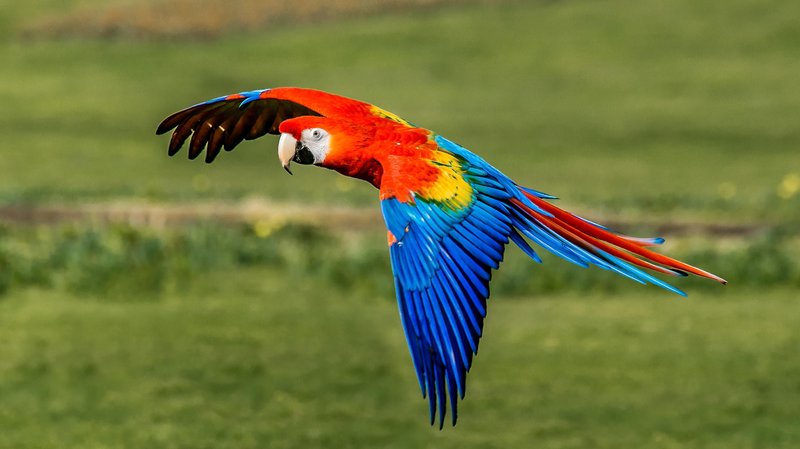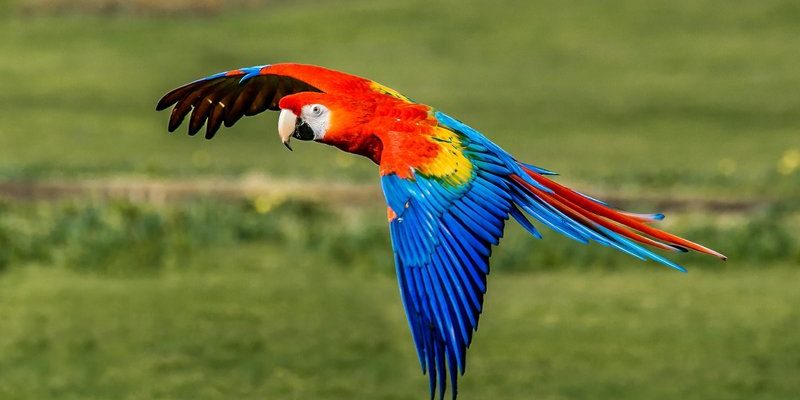
From their diet and social behavior to their nesting habits, every aspect of a scarlet macaw’s life reveals how they’ve evolved to fit perfectly into their tropical habitat. It’s like a carefully choreographed dance, where every move helps them find food, escape danger, and raise their young. In this article, we’ll dive into the fascinating ways scarlet macaws adapt to their environments, making them resilient and iconic inhabitants of Central and South American rainforests.
Coloration and Camouflage
One of the most striking features of scarlet macaws is their vivid red, yellow, and blue feathers. While these colors make them a visual feast for birdwatchers and photographers, there’s a practical reason behind them, too. The brilliant plumage helps them blend into the dappled light of the rainforest. With sunlight filtering through the leaves, their colors break up the outline of their bodies, making it harder for predators to spot them.
But it’s not just about evading danger. Those bright colors also play a crucial role in communication. Scarlet macaws are social animals and use their colors to signal to their partners and other flock members. You might be wondering how a bird can be both eye-catching and camouflaged at the same time. Well, by using their environment cleverly—perching among brightly colored flowers or leafy branches—they can show off their colors without drawing too much unwanted attention.
Dietary Adaptations
Scarlet macaws are primarily fruit eaters, but their diet isn’t limited to just one food source. These birds are known for their ability to consume a variety of foods, including nuts, seeds, and flowers. This adaptability is critical in their rainforests, where food availability can change with the seasons. By having a diverse diet, scarlet macaws can still find sustenance even when one food becomes scarce.
The strength of their beaks also plays a role in their feeding habits. Their large, curved beaks can crack open tough nuts and seeds that other birds couldn’t manage. This gives them access to a food source that’s often untouched by competitors. Plus, they’re not shy about using those strong beaks to munch on leaves and reach new food sources.
Nesting Habits and Reproduction
When it comes to nesting, scarlet macaws are quite resourceful. They typically nest in the hollows of tall trees, which offer both safety and protection for their eggs and chicks. These nesting sites are elevated away from ground predators, making it less likely that their young will fall prey to hungry animals. A little bit like choosing the best seat in a busy café to avoid distractions, nesting high in the trees helps keep their babies safe.
Scarlet macaws also tend to mate for life, solidifying their bond over time. They often share responsibilities when it comes to raising their young, taking turns to care for the chicks. This teamwork ensures that the chicks receive the attention and feeding they need to grow strong, which is essential in their competitive environment.
Social Structures and Communication
Scarlet macaws are not lone wanderers; they thrive in social groups. They often live in small flocks, which provide safety in numbers. When a potential predator is near, the entire flock can raise a racket, warning each other and distracting the threat. It’s like a well-organized alarm system in the treetops.
Communication goes beyond their loud calls, which can carry through the forest. Scarlet macaws also use body language. For example, a bird might fluff its feathers or perform specific movements as a way to signal distress or excitement. These social behaviors help strengthen their bonds and ensure their survival in a sometimes hostile environment.
Intelligence and Problem Solving
Scarlet macaws are incredibly intelligent birds. They have a knack for solving problems, which is vital in the wild. For instance, they can figure out how to open tricky fruit selections or even manipulate their environment to access harder-to-reach food sources. This intelligence allows them to adapt to changes in their habitat and find new ways to thrive.
Their ability to learn from one another is also impressive. Young macaws often watch their parents and other flock members to learn important survival skills. You might even catch them imitating calls or behaviors, which helps them fit into their social structure. This kind of learning is a fundamental part of how they adapt to ever-changing environments.
Habitat Conservation and Adaptation Challenges
Unfortunately, scarlet macaws face increasing challenges due to deforestation and habitat loss. As their rainforest homes diminish, these birds must adapt even more to survive. Some have begun to alter their ranges and move into areas where they previously wouldn’t have ventured. This change shows just how resilient they can be, but it also raises concerns about their long-term survival.
Conservation efforts are vital in helping these magnificent birds thrive. Protecting their natural habitats and supporting sustainable practices can help ensure that scarlet macaws continue to flourish. It’s a bit like tending to a garden; if you want it to thrive, you need to nurture and protect it.
Scarlet macaws are a testament to the wonders of nature and the intricate ways species adapt to their environments. From their stunning colors and strong beaks to their social structures and intelligence, each characteristic serves a purpose that enhances their survival.
By understanding how these birds adapt, we not only appreciate their beauty but also recognize the importance of protecting their habitats. Every small effort can make a significant impact on ensuring these beautiful birds continue to thrive in the wild. So, the next time you spot a scarlet macaw, remember all the incredible adaptations that allow them to dance gracefully through their lush environment.

